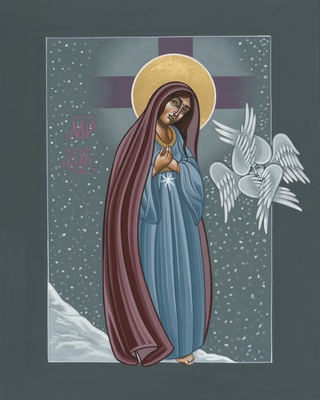Sale on canvas prints! Use code ABCXYZ at checkout for a special discount!

Nuestra Senora de las Nieves (Our Lady of the Snows)
“Wisdom will praise herself, and will glory in the midst of her people. In the assembly of the Most High she will open her mouth, and in the presence of His host she will glory: ‘ I came forth from the mouth of the Most High, and covered the earth like a mist. I dwell in high places, and my throne was in a pillar of cloud...in the waves of the sea, in the whole earth, and in every people and nation I have gotten a possession.
Then the Creator of all things gave me a commandment, and the one who created me assigned a place for my tent. And he said, ‘Make your dwelling in Jacob, and in Israel receive your inheritance,’ From eternity, in the beginning, he created me, and for eternity I shall not cease to exist...
I am the mother of fairest love, of fear, and of holy hope; being eternal, I am therefore given to all my children, to those who are named by him. I will shine forth like the dawn, and I will make it shine afar; I will again pour out teaching like prophecy, and leave it all to future generations. Observe that I have not labored for myself alone, but for all who seek instruction.”
Ecclesiasticus 24
These words always echo the words of Jesus, Holy Wisdom, especially in the long poignant soliloquy’s in the Gospel of St John. And in the mist or clouds hovering around the Sandia Mountains I always see the Shekhinah and Holy Wisdom as she describes herself in the above passage.
A few years ago a friend of mine told me his wife was suffering from cancer and he wanted to give her an original icon for Christmas. He had saved an old black and white holy card of the Blessed Mother pregnant with adoring angels at her feet and a Cross glowing in the background. It was done in an Art Nouveau style and he wanted it transformed into an icon. I looked at the holy card for a long time and had to make a decision about the meaning of the symbols in the card.
At the beginning of my apprenticeship I read an article by the genius Russian mystic Valentin Tomberg ( author of the incomparable Christian Hermeticist “school” of “Meditations on the Tarot”) about the meaning of the word and experience of “joy” for Russians and Americans. It helped me a lot because I was always being asked why the icons of the Mother of God we’re not smiling, “not happy.” As an American I could understand the thinking but I also gradually understood and respected the deep serenity and inner joy of the ancient icons. I also experienced this kind of quiet, introverted joy with the Native Peoples of Taos Pueblo and the Hispanic Taosenos. This ancient combination of cultures provided a perfect place for me to grow into a vocation as an iconographer.
In this icon the Mother of God is pregnant and on her womb is a star to signify the holy child within. She is looking into you . Will you share with her the miracle she carries in her womb? A Seraph replaces the adoring angels; in Icons the Seraph is present whenever the Son of God is near. The softly glowing Cross is behind her, in her future, a reminder of why the Child took a human body and became flesh. Living in Manhattan especially, I always noticed how falling snow made everyone quiet and they would move carefully along the sidewalks of New York, holding umbrellas looking like they stepped out of a Japanese print by Hiroshige or Hokusai. It was really beautiful.
I tried to create the delicate silence of snow falling in this icon to quiet the viewer/pray-er, into a natural contemplation.
This year we are fast approaching Gaudete Sunday and we rejoice (Gaudete!) in the midst of all that the world throws at us, which is considerable and not to be denied, that this Incarnation is the truth and our joy. It is the way we move forward like St Joseph and live in faith and trust in the midst of whatever may come.
I pray with the beautiful prayer/motet (BWV 229) written by Paul Thymich composed by J S Bach, in 1684, “Komm, Jesu, Komm!”
Fr William Hart McNichols 💮 Gaudete Sunday 2021